The String of pearls vine creates an interesting, elegant lacy effect as it cascades prettily over the sides of your planter. String of pearls care is very easy. We give you all the tips you need to maintain a healthy plant.
The Rosary string of beads is great for hanging baskets or a shelf plant.
You won’t find pod shaped leaves like this just anywhere. String of pearls plant is eye catching.
Like the String of hearts and the String of Turtles, ‘the pearls’ is also easy to fall in love with. They are unusual and lend themselves to interesting uses.
These are succulents. So they need little care. In fact, overwatering and overfeeding a string of pearls will kill it. If you are prone to overwatering I recommend a moisture meter.
Check the moisture every time you want to water your plant. The strings potting soil will look dry. But you cannot see the roots. They are what matters. Don’t add water unless the plant soil is dry around the roots.
When your string of Pearls actually begins to shrivel and the pods sink in…you might want to give the poor thing a sip or two. 🙂
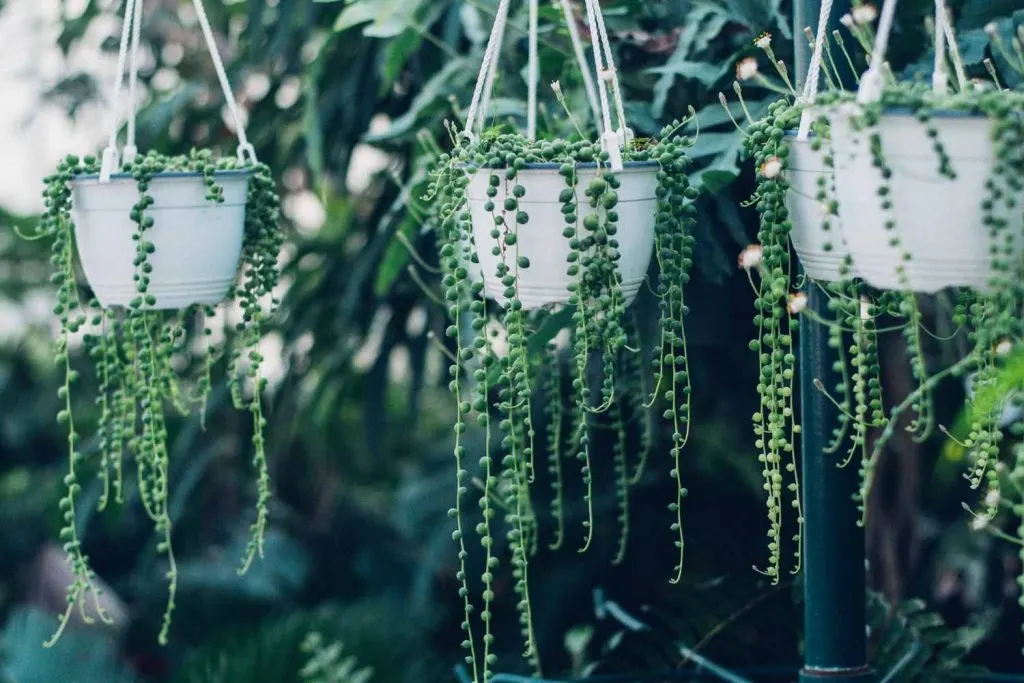
String of Pearls Flower:
String of pearls have the CUTEST little flowers with a light cinnamon scent. That’s something to look forward to.
Healthy, well fed plants with lots of energy will create flowers. Follow the care guide to learn how to properly take care of your pearls.
One trick to forcing flowers. Keep the pearls at an even temperature of 60 degrees during the winter months. In spring, your plant should feel like flowering when it warms up.
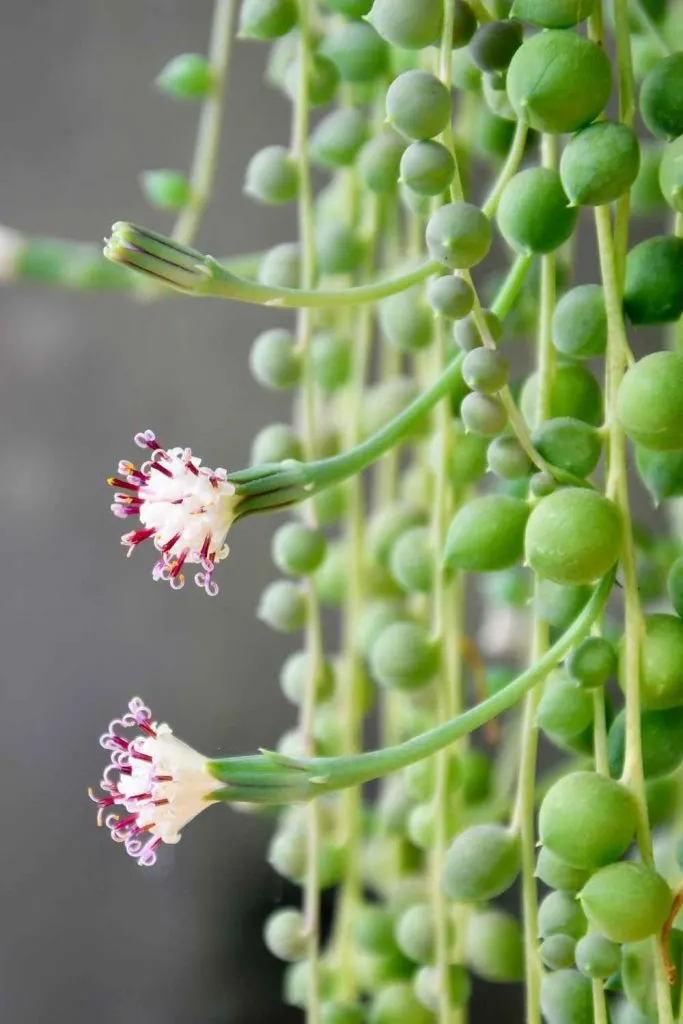
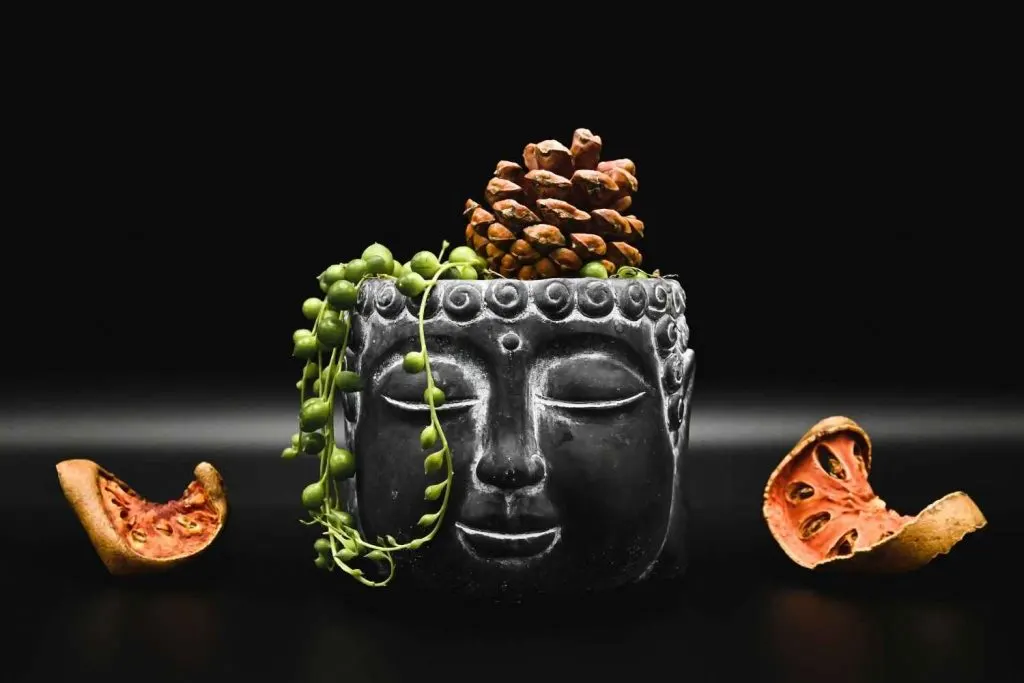
Growing String of Pearls Outdoors:
You can grow the String of Pearls succulents outdoors in zones 9 or warmer. They don’t mind the high heat and light of arid climates.
String of pearls care outdoors is simple. But you will have to keep them partially shaded or the leaves will burn and shrivel.
If the weather gets cooler than 50 degrees F. bring them inside and grow them as a houseplant.
Where I live in the cold north these are definitely houseplants. Even our summers are risky for growing the pearls outdoors.
You need to keep your string plants away from chilly drafts. Growing them indoors give you an easier way to regulate the heat to 70 degrees F or warmer.
These cute plants create an interesting and elegant look when properly placed.
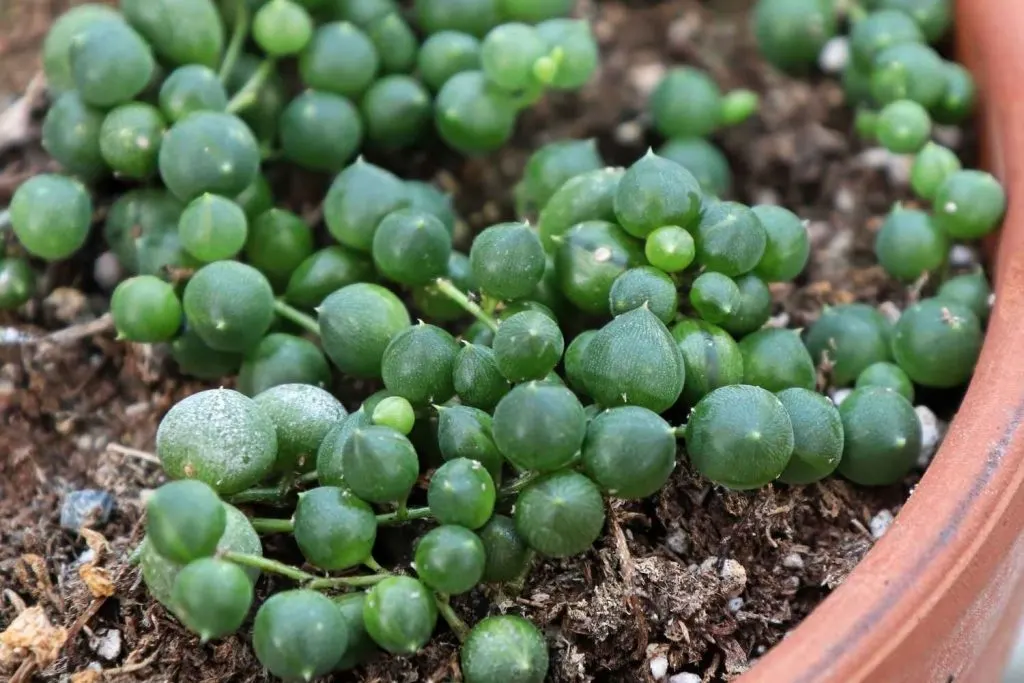
String of Pearls Care:
This is an easy care succulent plant.
Don’t overwater these succulents or over feed them. Read our complete care guide below for More details.
At the bottom of our care card you will find a video of Kayti propagating her string of hearts. Propagating string of pearls is similar.
String of Pearls Care Guide
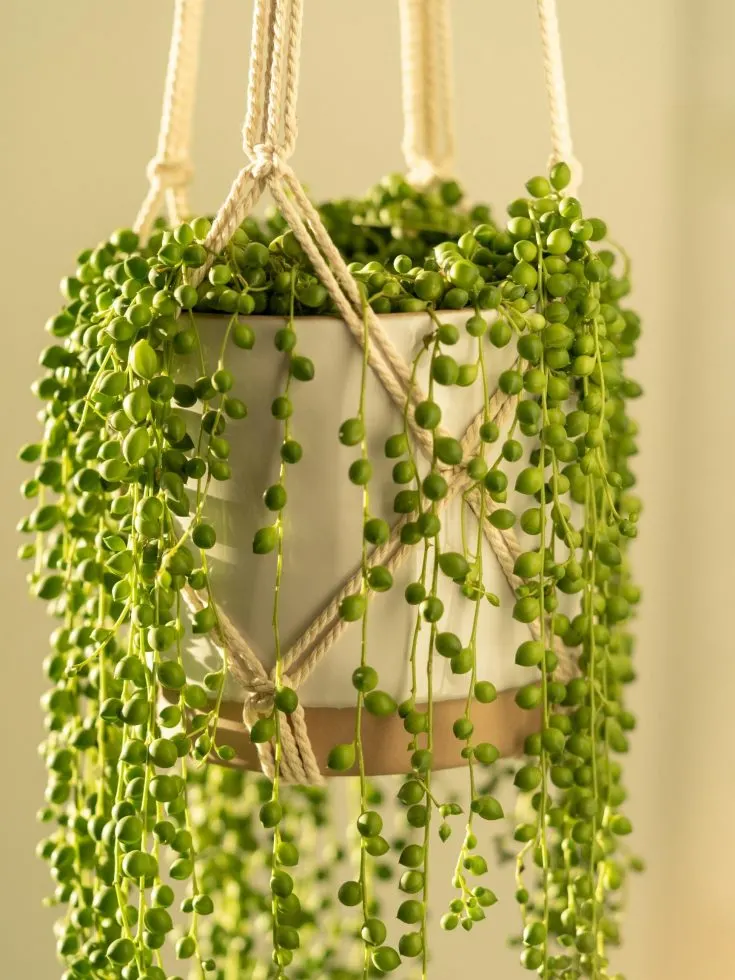
Senecio Rowleyanus plant is commonly known as the String of Pearls.
This plant has perfectly round green leaves. As the plant grows the pod like leaves grow over the side ot the pot. They grow in a long vine. The String of pearls is an easy to grow succulent plant.
This Care Guide will teach you how to keep this houseplant happy all through the year.
Materials
Tools
- Pot (ceramic, plastic, or terra cotta)
- Scissors
- Rubbing Alcohol
- moisture meter
Instructions
Soil Preference:
- String of Pearls prefer well draining soil. The roots will rot quickly if they sit in moist soil.
- A mix of cactus potting mix and perlite will keep the roots happiest.
- Make sure your pot has drainage at the bottom. Do not use a pot with no drainage hole for this plant.
- A heavy soil potting mix is not recommended for succulent String plants.
Pot Size and Type:
- The String of pearls plant can grow in many different kinds of pots IF THEY HAVE GOOD DRAINAGE.
- I like to plant mine in ceramic pots with a drainage hole. Terra cotta pots are ideal since they wick extra liquids away from the roots.
- Unglazed ceramic pots are also good choices.
Repotting Tips:
- The delicate roots are shallow and can go most likely two years between potting. Look for roots coming out the drainage holes.
- These plants do well in small pots that fit the root size.
- Potting in a too large planter can encourage root rot and other problems.
- They enjoy being shallowly planted right at the top of the pot lip.
- If the plant pot lip is too high, the pods are deeply buried under each other rather than trailing out of the pot. This encourages rot and mold.
- Set them up properly with a well draining pot that fits the roots and use a good porous soil.
- Plant the pearls to the top of your pot so they have a dry surface to grow on and over without stacking into a pile before spilling over the sides.
Lighting:
- The Pearls will grow best in bright indirect light. These pretty succulents enjoy growing near a well lit southern or western window, or nearby shelf.
- Make sure the String of pearls plant isn't sitting in constant direct sunlight, the leaves can burn and fall off.
- Sheer curtains make good light filters.
Watering:
- Water your String of pearls plant when the soil is dry at least an inch down. These plants are typically drough resistant and can withstand longer periods of dryness compared to other houseplants.
- A good test to tell if it needs watering is the leaves. If string of pearls is shriveling, then the plant needs a good watering.
- Watering is best done on a regular schedule so the plant is not over or under watered. Both can cause stress on the plant.
- The recomendation for watering is every 2-3 weeks. Use a moisture meter to be sure.
- In dormant winter months reduce watering to when the soil is dry.
- Never let this plant get wet feet. Overwatering causes yellowing leaves, root rot and attract fungus gnats to your plant.
- Keep humidifiers and plant misters away from these low humidity plants.
- Occasional showering to get the dust off is fine. Bur dry the pearls WELL afterward. Set it outside in warm air and let it dry that way if you can.
How to Fertilize:
- Apply a good quality fertilizer (linked in materials) monthly through Spring and summer.
- Decrease feedings by late Fall and allow the String of Hearts plant to rest through the winter months.
Temperature:
- The String of pearls plant will do best in temperatures between 70-85 degrees Farenheit.
- If it is warm outside during the summer, you can put this plant outside. However, take care not to let the leaves get burned from constant direct sun.
- And the night temperatures should be over 60 degree F. Never below 50 degrees to avoid injuring the plant.
Pests:
- The String of pearls plant is a hardy resilient plant. However all plants can get attacked by pests.
- Stress by longterm overwatering, poor light, extreme temperatures and soil conditions are contributors to plant stress..
- Spider mites, mealy bugs, scale, thrips and whitefly are the most common houseplant pests you will see.
- Read our post on How to get rid of aphids and other pests with our homemade pesticide soap recipe or neems oil.
- To minimize the possibility of pests be sure to check all nursery plants before bringing them home.
- Quarantine all new plants until you are sure no pests live in them.
How to Propagate:
- Propagation for the string of pearls is similar to the string of hearts plant. Be sure to read our post on How to Propagate the String Of Hearts for more information.
- Cut vine off the plant using sterile scissors
- Place vine in water cut side down
- Place near a window with bright indirect light
- After several weeks roots will grow
- Plant in soil when roots are 2-3 inches long
- If you want to propagate in soil, cut off a hanging section from the vine.
- Place the vine directly in moist soil and a new vine will evenutally grow.
Notes
The String of pearls Plant is a beautiful addition to any plant hobbysists collection.
It can grow lovely and long, cascading down the sides of your pot with proper care and pruning.
String of pearls is propagated similarly to string of hearts. Watch our video below for propagation ideas!
Toxic Plant:
Unfortunately these plants are toxic to pets and people. Not lethally; but they will make you and your pets sick if you take a notion to eat them. 🙁
The pearl strings are especially attractive to cats and puppies that like to bat the beads and chew them. Keep them apart for the safety of both pets and plant.
Beware Peculiar Colors:
Have you seen a Blue String of Pearls? How bout purple or red? If so, RUN in the other direction.
Online sellers that promise uniquely colored pearls are outright lying to you. Don’t buy those seeds.
Plants, Including the variegated string of Pearls, require photosynthesis to feed themselves. That takes chlorophyll. Which is green. Some part of the plant leaf must be green to make this work.
Pictures of bright pure red, purple and blue string of pearls sold as seeds are photoshopped fakes.
Further Reading:
Here’s a great article from SucculentsBox.com .
Related Content:
Follow Us:
Find us on YouTube, Instagram , Pinterest and TikTok! We love to Plant chat. We also comment, like and occasionally share your content to our daily stories. We’d love to see your plants. Share your joy in your houseplants. Happy Planting!
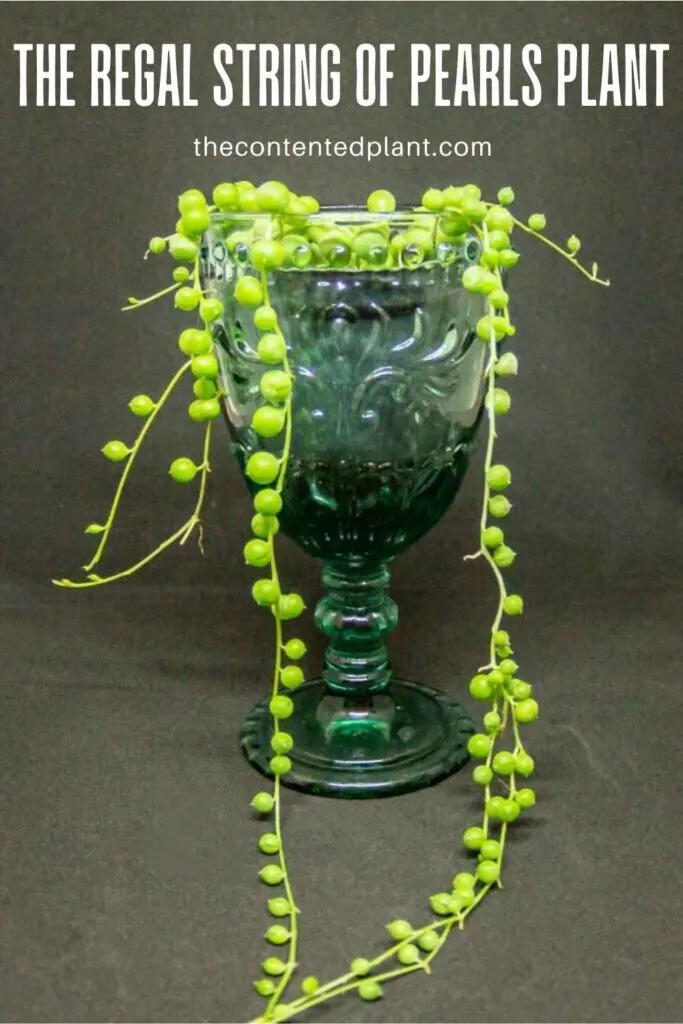

String of Dolphins Plant Care - The Contented Plant
Friday 13th of May 2022
[…] String of Pearls Care Guide and Plant Profile […]
String of Hearts Watering Guide - The Contented Plant
Thursday 24th of February 2022
[…] most succulents, the Sweetheart vine and other string of things plants are pretty tolerant of neglect and poor conditions. With ONE […]
The Best Hanging and Trailing Plants for your Home - The Contented Plant
Wednesday 9th of February 2022
[…] String of Pearls plant in hanging […]